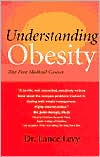Understanding Obesity: The Five Medical Causes
Dr. Levy believes that very few overweight people are overweight because they are too lazy to go for a walk. Every obese person who has struggled to lose weight know what an average breakfast, lunch, and dinner should look like. For various reasons, however, they are unable to follow an average meal plan. This book explains why.\ Understanding Obesity focuses on the causes of obesity. Ninety percent of obesity is caused by mood disorders, chronic tiredness, chronic pain, chronic...
Search in google:
An authoritative book that focuses on the causes of, and the treatment for, obesity. Obesity is usually related to other health problems and treatment for them is the first step. Levy stresses that this is a medical problem not a character flaw. Science Books and Films, April 2001 - John D. Chilgren [This] authoritative, common sense, and easy-to-comprehend book is successful, whereas others' efforts have failed.
Introduction\ There's No "One- Size-Fits-All" Method for Losing Weight\ This book is intended as a guide for anyone who is overweight and looking for sensible approaches for dealing with the problem. In these pages I describe what we currently know about the causes and management of obesity. We are on the verge of having a useful understanding of the complex reasons why people become obese, and I discuss these in some depth. It is only fair to warn you, however, that completely successful methods of weight loss are still far off, and successful long-term treatments are difficult to devise. \ Let us start with two basic questions. First, what is obesity? And second, why should anyone worry about it? The World Health Organization's criteria for Body Mass Index (BMI) have recently been adopted as the universal standard for defining levels of overweight and obesity. (The Body Mass Index is your weight in kilograms divided by the square of your height expressed in centimeters.) A Body Mass Index of less than 18.5 signifies malnutrition or significant underweight, a BMI from 18.5 to 24 is normal, from 25 to 29 is overweight, and above 30 indicates obesity. Though using BMI alone as a measure of weight problems has its limitations (as will be discussed later), according to the recent Canadian Heart Health Survey, approximately 44 percent of men and 25 percent of women have a BMI of 25 to 29 (overweight). Thirteen percent of men and 14 percent of women have a BMI over 30 (obese). Therefore, if we take a BMI of 24.9 as the cutoff above which an individual is too heavy, 57 percent of men are overweight or obese and 39 percent of women are in the same category. Thus, fully 48 percent of our adult population are excessively heavy. In the United States, using slightly different cut-offs for BMI, 31 percent of adults have a BMI of 25 to 30, and 21 percent have a BMI above 30 and so are obese.\ There is also a very disturbing trend in the development of weight problems in our children. In 1981, 15 percent of children were overweight or obese, while in 1998, 24 percent were overweight or obese. (The concept of an "ideal" weight raises further questions, but for now let's accept that there is an approximate "healthy" weight for most people.)\ The reason we need to be concerned is that excess weight is the cause of more illness than virtually any other medical condition. Even in the poorest countries, obesity is becoming epidemic, causing significant ill health from diabetes and heart disease where these were relatively rare thirty years ago. In the western industrialized countries, many more people will have to see a doctor because of complications arising from overweight than will develop cancer! For example, 80 percent of adult-onset diabetes occurs in people who are overweight or obese. Diabetes, heart and vascular disease, high-blood pressure (hypertension), gallbladder disease, arthritis, sleep apnea (a condition where people fail to breathe adequately during sleep), and gastrointestinal ailments are just some of the health problems that can afflict the overweight person.\ Not surprisingly, the medical and socioeconomic costs of obesity are high. Of all the health-care dollars spent in the United States in 1990, 6.8 percent (about $34 billion) were spent on the physical and psychological treatments directly associated with obesity. In Canada, 2.4 percent of the health care budget was spent for these problems. It is important to note that these costs are for the treatment of obesity-related problems (such as heart disease) only and do not include the additional costs that occur where, for example, wages are lost due to obesity-linked illness such as arthritis, high blood pressure, and early death. From a public-health perspective, allowing this illness to remain so poorly researched and treated has been a very costly mistake for governments. The fact that governments have begun to approve weight-control drugs for the long-term management of serious obesity is a step in the right direction. Another positive step is the search for weight-management approaches that will work with children and adolescents who will undoubtedly become fat adults if left untreated.\ Obesity has increased in the past decade. There are a number of possible reasons why this is so. Several that I am particularly interested in are the use of poorly devised diets, the effects of advertising on dietary food choices, food manipulation to enhance palatability, and the role of stress in promoting weight gain. As an example of the first, the increase in overweight may be in part linked to the dietary approaches in most common use, such as the advocacy of quite low-fat diets and diets that are more than 500 to 750 calories below that needed for weight maintenance (for example, a 1200-calorie diet for a man weighing 300 pounds (136 kg) whose calorie requirement for maintaining weight would be roughly 3500 calories). This may seem contradictory, but as I explain later, low-fat diets (those with fewer than 25 percent of their calories from fat) and excessively deprivational diets can encourage weight to be regained.\ It is true, too, that our society is becoming increasingly "hostile" to sensible food management, because the food industry has invested heavily to make foods as flavorful and appealing as possible and to encourage us, through advertising, to eat when we are not hungry. When food is very tasty we eat more. Since it may also be high in fat and we are not burning enough calories, we gain weight. Also, we are under more stress now than twenty years ago, and people often eat in an attempt to relieve stress and maintain energy. Last but not least, as a society we are less active now than in previous decades. Our children are particularly inactive compared to their counterparts of forty years ago. Inactivity makes it much harder to balance food intake against calories expended.\ I have looked after patients with weight-control problems for the past fourteen years. The weight-loss efforts of most of these people were complicated by unrecognized and usually untreated or partially treated medical problems such as those mentioned above. Managing weight loss with a patient is one of the most challenging projects a doctor and patient can work on together. There are more failures than successes because obesity is such a complex problem. Because no two overweight people are overweight for the same reasons, simple dietary instruction and advice such as "be more active" are rarely effective. In-depth assessment and treatment are needed, particularly when a person has been overweight for a long time or is very overweight.\ It is all too easy to spend a lot of time and money trying to lose weight in ways that will not work or that are almost certainly harmful, either because they predispose the dieter to more weight gain later or simply because they are unsafe. North Americans spent tens of billions of dollars last year on various weight-loss approaches, but many of the people who go to a commercial diet center regain the weight they lost within two years and often end up heavier than they were before they dieted. Research shows that only about thirty-five out of every hundred moderately obese people who undertake one of the best medically devised weight-loss plans will lose 15 percent of their starting body weight and maintain that loss after two years. Claims that are better than this are unlikely to be reliable.\ The approach described in this book is radically different from that of most weight-loss programs. Instead of offering a "one-size-fits-all" recipe for losing weight, it looks at weight loss as a highly individual matter. Weight management is a complex task involving both emotional and physical factors. This book outlines some of the reasons why weight loss is hard and the physics behind why we gain or lose weight. It explains the various methods of medically evaluating a patient and of managing the weight-loss process. All weight-loss strategies have to be individualized if they are to work. Medically supervised drug management of appetite is an important part of treating serious obesity, and a chapter is dedicated to this topic.\ Problems with mood, such as anxiety, depression, and chronic unhappiness states (dysthymia), are very common. Patients often believe that their mood will improve as weight loss proceeds, but though a person may temporarily feel less depressed or unhappy while he or she is losing weight, long-term improvement in mood is rarely the result of weight loss alone. One chapter explains why weight-loss approaches that ignore mood problems will generally not succeed, while approaches that treat mood problems and weight problems together can be helpful. In my experience, the majority of overweight people succeed in losing weight only when they are feeling more positive about life.\ In keeping with the focus on the person rather than the diet, this book reviews several well-known diets but cannot honestly advocate any one of them. The reasons why we don't promote diets — even a Canada's Food Guide 1500-calorie diet — are simple.\ Our studies on dietary awareness show that obese patients can usually identify helpful changes they could make in their diets. Almost any of these changes, if put into practice over the long term, would result in sustained and adequate weight loss. Therefore the real challenge in helping a person lose weight is in understanding why that intelligent person cannot make these changes. Understanding why people are not making changes is more important than counting their calorie intake. It is not very helpful to coach adults on how many teaspoons of mayonnaise they should use in their tuna sandwich. In fact, doing so merely proves to them that you don't really understand why they have weight problems. It is more constructive to help people identify the things that are preventing them from eating properly than to lecture them on diet theory. Everyone knows that to achieve weight loss over time a person needs to consume fewer calories than are burned. It sounds as though losing weight should be a simple, almost mechanical process. In fact, however, people cannot reduce their calorie intake over the long term until they understand how to control their appetite. The choices we make about what food to eat, the timing of meals, the balance of protein, fat, and carbohydrate, and activity level all affect appetite. Above all, patients need to learn how to interpret and respond to appetite signals and to find ways to increase activity level. The diet theory can wait till later.\ Every strategy for weight loss is based on a particular philosophy. If there were one that was completely right, I wouldn't be writing this book. I believe that any weight-loss book can be helpful if it does two things well. First, its suggestions must be rooted in the actual experiences of people who have struggled with overweight and tried different approaches. Second, it must approach weight-control issues as true medical problems, not just a matter of summoning up a little self-restraint and willpower.\ My weight-loss strategy is based on my observation that you will not succeed in losing weight and keeping it off until your medical/psychological problems are treated and improvement has been secured, and your thinking about weight loss has changed in the following ways:\ \ First, you must find a meaningful, personal, "core" reason to lose weight.\ \ Here is an example. One of my patients, "Kathy" (not her real name), a nurse in her thirties, weighed over 320 pounds (136 kg). Over a three-year period we tried every weight-loss approach I knew, including various medications. She had been managed very well for a bipolar disorder (abrupt, extreme mood swings), and had been put on supplemental air for sleep apnea (a condition where a person does not breathe enough during sleep). Nevertheless, despite all her efforts, she did not lose weight. She had such bad arthritis in both knees that she was likely to be in a wheelchair within five years. As a last resort, I suggested stomach surgery and referred her to a surgeon. (I add that I recommend gastric surgery for obesity only when I am persuaded that no medical option remains, and that the patient will suffer serious medical consequences from the obesity. I must also be satisfied that the patient is psychologically fit for this procedure.) just after I made the referral, the patient began to lose weight, and in five months lost nearly 50 pounds (22 kg). What, I asked her, had suddenly changed in her thinking? She said that with the referral to a surgeon, she realized on a very intense, deep level, that her freedom, her career, and indeed her whole life were about to go up in smoke because of her obesity. She said that she was totally determined never to end up in that wheelchair. Finally, she had a reason to lose weight that really meant something to her. The things she valued most deeply were being put at risk by her obesity, and she had come far along enough in her psychotherapy to finally confront that reality honestly.\ \ \ Second, you must accept that there is a cost to everything, including health.\ \ When other aspects of their lives are difficult, people may feel that the effort needed to maintain good health is too much for them. But when they come to appreciate that staying healthy is a prerequisite for holding onto the things they have worked hard to achieve, they can succeed in losing weight and keeping it off. Although we cannot subordinate all other aspects of life to health issues, we do have to decide to adjust our priorities to protect health. For example, building time for physical activity into the day is essential even if it means saying no to other responsibilities-including even some work-related ones.\ \ \ Third, you must feel capable of dealing with the fears, insecurities, or negative thoughts that prevent you from changing.\ \ Think of the word "fear" as an acronym that stands for Fantasy Experienced As Reality. Many of the obstacles my patients report that prevent them from changing their lifestyles are more imaginary than real. The "obstacle" is that they see a required change as dangerous. For example, they may be reluctant to ask for flexible hours at work in order to take an hour's walk at lunch break, imagining that the boss will think them too demanding and refuse, or become angry and punitive. They may remember similar events when they were children or adolescents and couldn't adequately explain their needs, forgetting that as adults they are very capable of making their case.\ \ Becoming less afraid allows them to reorganize their day without feeling guilty about it. When they do this, most people find that friends and colleagues support their efforts. The resistance they worried about does not materialize.\ \ As I said early in this introduction, the treatment of weight problems is a complex matter. This is partly because each person is unique and partly because there are so many physiological and psychological dimensions to our use of food. In the rest of this book, I look at different aspects of the problem in more detail. The next two chapters describe the eating patterns that most commonly accompany weight problems and examine some of the reasons why people can become locked into such patterns. Three chapters are then given over to aspects of the physiology of weight gain, and another chapter to the need to treat medical conditions that can make it hard for people to lose weight. In two subsequent chapters, I evaluate some approaches to weight loss that are currently in use and then discuss my own approach, which focuses on finding out what works best for the individual. The last four chapters deal with a variety of topics, including the use of drugs in weight management, childhood obesity, controlling weight gain under a variety of special conditions (such as pregnancy), and more invasive forms of treatment (such as gastric surgery).\ It is my hope that the information that follows will provide helpful insights into the physical and emotional aspects of weight loss and weight gain, and will enable you, the reader, to find answers and solutions to fit your own individual circumstances.
Introduction: There's No "One-Size-Fits-All" Method for Losing Weight It's How (and Why) You Eat, as Well as What You Eat: "Disordered Eating" and Weight GainThe Search for ReasonsWhat Should You Weigh?Understanding Appetite and the Laws of Weight Loss and Weight Gain Food and Your Brain: A Delicate InteractionEssential First Steps: Dealing with Medical ConditionsCutting Some Popular Diets Down to SizeA More Effective Approach: Finding Out What Works for YouUsing Drugs in Weight ManagementChildhood Obesity: Causes, How to Detect It, and What to Do About It Special Conditions That Affect Weight ControlWhen Medical Means Fail: What Other Measures Can -- and Can't -- Achieve PostscriptAppendicesIndex
\ John D. Chilgren[This] authoritative, common sense, and easy-to-comprehend book is successful, whereas others' efforts have failed.\ —Science Books and Films, April 2001\ \








